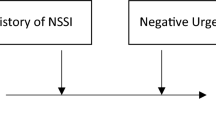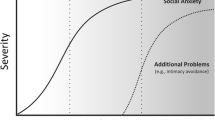Abstract
Cognitive bias in the misinterpretation of ambiguous interoceptive stimuli has been demonstrated in panic disorder. This study investigated whether this cognitive bias also occurs in people with nonclinical panic who are at risk of developing panic disorder. The responses of 25 people with nonclinical panic were compared to those of 20 people with panic disorder and 69 nonpanic controls on a measure of interpretive bias, the Brief Body Sensations Interpretation Questionnaire. There was evidence for interpretive cognitive bias for ambiguous interoceptive stimuli among the nonclinical panickers which did not differ from that of the people with panic disorder, but which differed from the nonpanic controls. High anxiety sensitivity predicted interpretive bias toward both interoceptive and external stimuli. Results therefore suggest that interpretive cognitive bias for ambiguous interoceptive stimuli may be a risk factor for the development of panic disorder.
Similar content being viewed by others
REFERENCES
American Psychiatric Association. (1994). Diagnostic and statistical manual of mental disorders (4th ed.). Washington, DC: Author.
Barlow, D. H. (1988). Anxiety and its disorders: The nature and treatment of anxiety and panic. New York: Guildford Press.
Barlow, D. H. (1991). Disorders of emotion. Psychological Inquiry, 2, 58–71.
Brown, T. A., DiNardo, P. A., & Barlow, D. H. (1994). Anxiety Disorders Interview Schedule for DSMIV. New York: Graywind.
Butler, G., & Mathews, A. (1983). Cognitive processes in anxiety. Advances in Behaviour Research and Therapy, 5, 51–62.
Clark, D. M. (1988). A cognitive model of panic attacks. In S. Rachman & J. D. Maser (Eds.). Panic: Psychological perspectives (pp. 71–89). Hillside, NJ: Erlbaum.
Clark, D. M., Salkovskis, P. M., Breitholtz, E., Westling, B. E., Ost, L.-G., Koehler, K. A., Jeavons, A., & Gelder, M. (1997). Misinterpretation of body sensations in panic disorder. Journal of Consulting and Clinical Psychology, 65, 203–213.
Coakes, S. J., & Steed, L. G. (1996). SPSS for windows: Analysis without anguish. Brisbane, Australia: Jacaranda Wiley.
Cox, B. J., Borger, S. C., & Enns, M. W. (1999). Anxiety sensitivity and emotional disorders: Psychometric studies and their theoretical implications. In S. Taylor (Ed.), Anxiety sensitivity: Theory, research and treatment of the fear of anxiety. Mahwah, NJ: Erlbaum.
Cox, B. J., Endler, N. S., & Norton, R. G. (1994). Levels of “nonclinical panic.” Journal of Behaviour Therapy and Experimental Psychiatry, 25, 35–40.
Cox, B. J., Endler, N. S., & Swinson, R. P. (1995). Anxiety sensitivity and panic attack symptomatology. Behaviour Research and Therapy, 33, 833–836.
Cox, B. J., Endler, N. S., Swinson, R. P., & Norton, G. R. (1991). Situations and specific coping strategies associated with clinical and nonclinical panic attacks. Behaviour Research and Therapy, 30, 67–69.
Cox, B. J., Parker, J. D. A., & Swinson, R. P. (1996). Anxiety sensitivity: Confirmatory evidence for a multidimensional construct. Behaviour Research and Therapy, 34, 591–598.
Ehlers, A. (1989). Interaction of psychological and physiological factors in panic attacks. In P. Lovibond & P. Wilson (Eds.), Clinical and abnormal psychology (pp. 1–14). Amsterdam: Elsevier Science.
Ehlers, A. (1995). A 1 year prospective study of panic attacks: Clinical course and factors associated with maintenance. Journal of Abnormal Psychology, 104, 164–172.
Harvey, J. M., Richards, J. C., Dziadosz, T., & Swindell, A. (1993). Misinterpretation of ambiguous stimuli in panic disorder. Cognitive Therapy and Research, 17, 235–248.
Kamieniecki, G. W., Wade, T., & Tsourtos, G. (1997). Interpretive bias for benign sensations in panic disorder with agoraphobia. Journal of Anxiety Disorders, 11, 141–156.
Keppel, G. (1991). Design and analysis: A researcher's handbook. Englewood Cliffs, NJ: Prentice-Hall.
Lau, J. J., Calamari, J. E., & Waraczynski, M. (1996). Panic attack symptomatology and anxiety sensitivity in adolescents. Journal of Anxiety Disorders, 10, 355–364.
Lilienfield, S. O., Turner, S. M., & Jacob, R. G. (1993). Anxiety sensitivity: An examination of theoretical and methodological issues. Advances in Behaviour Research and Therapy, 15, 147–183.
Maller, R. G., & Reiss, S. (1987). A behavioural validation of the Anxiety Sensitivity Index. Journal of Anxiety Disorders, 1, 265–272.
Maller, R. G., & Reiss, S. (1992). Anxiety sensitivity in 1984 and panic attacks in 1987. Journal of Anxiety Disorders, 6, 241–247.
McNally, R. J. (1990). Psychological approaches to panic disorder: A review. Psychological Bulletin, 108, 403–419.
McNally, R. J. (1994). Panic disorder: A critical analysis. New York: Guilford Press.
McNally, R. J., & Foa, E. B. (1987). Cognition and agoraphobia: Bias in the interpretation of threat. Cognitive Therapy and Research, 11, 567–581.
McNally, R. J., Hornig, C. D., Hoffman, E. C., & Han, E. M. (1999). Anxiety sensitivity and cognitive biases for threat. Behavior Therapy, 30, 51–61.
Peterson, R. A., & Helibronner, R. L. (1987). The Anxiety Sensitivity Index: Construct validity and factor analytic structure. Journal of Anxiety Disorders, 1, 117–121.
Rapee, R. M., Ancis, J. R., & Barlow, D. H. (1988). Emotional reactions to physiological sensations: Panic disorder patients and nonclinical subjects. Behaviour Research and Therapy, 29, 265–269.
Reiss, S. (1991). Expectancy theory of fear, anxiety, and panic. Clinical Psychology Review, 11, 141–153.
Reiss, S., Peterson, R. A., Gursky, D. M., & McNally, R. J. (1986). Anxiety sensitivity, anxiety frequency and the prediction of fearfulness. Behaviour Research and Therapy, 24, 1–8.
Richards, J. C., Edgar, L., & Gibbon, P. (1996). Cardiac acuity in panic disorder. Cognitive Therapy and Research, 20, 361–376.
Salkovskis, P. M., Clark, D. M., & Gelder, M. G. (1996). Cognition- behaviour links in the persistence of panic. Behaviour Research and Therapy, 34, 453–458.
Schmidt, N. B., Lerew, D.R., & Jackson, R. J. (1997). he role of anxiety sensitivity in the pathogenesis of panic: Prospective evaluation of spontaneous panic attacks during acute stress. Journal of Abnormal Psychology, 106, 355–364.
Schmidt, N. B., Lerew, D. R., & Jackson, R. J. (1999). Prospective evaluation of anxiety sensitivity in the pathogenesis of panic: Replication and extension. Journal of Abnormal Psychology, 108,532–537.
Spitzer, R. L., Williams, J. B. W., Kroenke, K., Linzer, M., & DeGruy, F. V., III. (1994). Utility of a new procedure for diagnosing mental disorders in primary care: The Prime-MD 1000 Study. Journal of the American Medical Association, 272, 1749.
Stewart, S. H., Knize, K., & Phil, R. O. (1992). Anxiety sensitivity and dependency in clinical and nonclinical panickers and controls. Journal of Anxiety Disorders, 6, 119–131.
Taylor, S., & Cox, B. J. (1998). An expanded Anxiety Sensitivity Index: Evidence for a hierarchic structure in a clinical sample. Journal of Anxiety Disorders, 12, 463–483.
Taylor, S., Koch, W. J., & McNally, R. J. (1992). How does anxiety sensitivity vary across the anxiety disorders? Journal of Anxiety Disorders, 6, 249–259.
Telch, M. J., Lucas, J. A., & Nelson, P. (1989). Nonclinical panic in college students: An investigation of prevalence and symptomatology. Journal of Abnormal Psychology, 98, 300–306.
Wilson, K. G., Sandler, L. S., Asmundsen, G. J. G., Ediger, J. M., Larsen, D. K., & Walker, J. R. (1992). Panic attacks in the nonclinical population: An empirical approach to case identification. Journal of Abnormal Psychology, 101, 460–468.
Zinbarg, R. E., Barlow, D. H., & Brown, T. A. (1997). The hierarchical structure and general factor saturation of the Anxiety Sensitivity Index: Evidence and implications. Psychological Assessment, 9, 277–284.
Author information
Authors and Affiliations
Rights and permissions
About this article
Cite this article
Richards, J.C., Austin, D.W. & Alvarenga, M.E. Interpretation of Ambiguous Interoceptive Stimuli in Panic Disorder and Nonclinical Panic. Cognitive Therapy and Research 25, 235–246 (2001). https://doi.org/10.1023/A:1010783427196
Issue Date:
DOI: https://doi.org/10.1023/A:1010783427196




